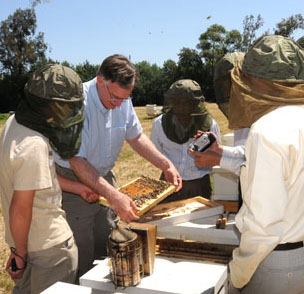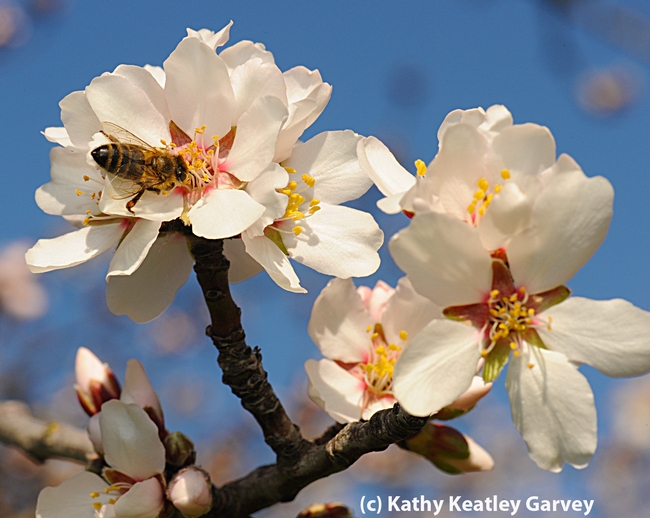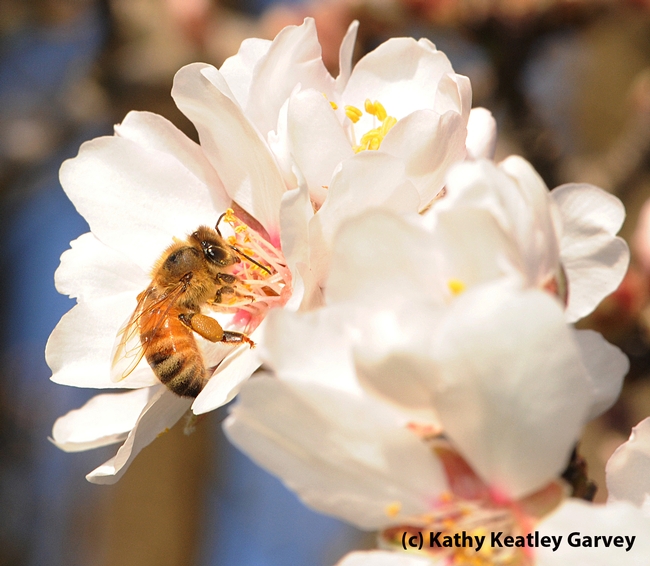
He sounded the alarm.
“We need 1.6 million colonies, or two colonies per acre, and California has only about 500,000 colonies that can be used for that purpose,” said Mussen in a news release we posted Feb. 8 on the Department of Entomology website. “We need to bring in a million more colonies but due to the winter losses, we may not have enough bees.”
Those winter losses--still being tabulated--and the resulting fewer bees per hive could spell trouble for almond growers, he said.
He said 2012 was a bad year for bee nutrition.
“Last year was not a good year for honey production in the United States,” Mussen said, “and it could be one of the worst honey production years in the history of nation, although it’s been pretty rough in some of the previous years. Usually when we’re short of nectar, we’re short on pollen, and honey bees need both. So, 2012 was a bad year for bee nutrition.”
The winter of 2012-2013, in general, was bad for bees. In fact, it's never been good since the winter of 2006 with the onset of colony collapse disorder, a mysterious malady characterized by adult bees abandoning the hive, leaving behind the queen bee, brood and food stores.
Bee scientists think CCD is caused by a multitude of factors, includes, pests, pesticides, parasites, diseases, malnutrition and stress. On the average, beekeepers report they're losing one-third of their bees a year.
“We don’t know how many more bees will be lost over the winter,” Mussen told us on Feb. 8. “We consider the winter ending when the weather warms up and the pollen is being brought into the hives.”
“Many, many colonies are not going to make it through the winter. We won’t have as large a bee population as in the past.”
Mussen, a member of the UC Davis Department of Entomology since 1976, knows honey bees. He is a honey bee guru, a global expert on bees. "Have a question about bees? Ask Eric Mussen." This month, especially, he is in great demand as a news source.
The New York Times quoted Mussen in its March 28th article, "Mystery Malady Kills More Bees, Heightening Worry on Farms."
Eric Mussen, an apiculturist at the University of California, Davis, said analysts had documented about 150 chemical residues in pollen and wax gathered from beehives.
"Where do you start?" Dr. Mussen said. "When you have all these chemicals at a sublethal leel how do they react with each other? What are the consequences?"
Experts say nobody knows.
Meanwhile, Mussen spent much of the day today granting news media interviews. On Tuesday, April 2, it will be for Dan Rather Reports: Buzzkill.
It was not so long ago that honey bees drew little attention, despite the fact that they pollinate about one-third of the food we eat. A three-letter acronym, CCD, changed all that.
Rich Schubert, a beekeeper in the Winters/Vacaville area, said it best during a question-and-answer session at Mussen's UC Davis Distinguished Seminar on Oct. 9, 2007.
If 5600 dead cows were found in a pasture, instead of 5600 dead bees, people would start paying attention, Schubert told the crowd.
So true. And now they are.
Attached Images:

